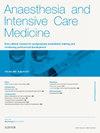社区获得性肺炎
IF 0.3
Q4 ANESTHESIOLOGY
引用次数: 0
摘要
社区获得性肺炎(CAP)是一种以非医院病原体引起的呼吸系统炎症变化为特征的疾病。下呼吸道感染的症状和体征包括咳嗽、呼吸困难、胸膜炎性胸痛、含黏液化脓性成分的痰,以及全身特征,如肌痛和发烧。老年患者更有可能出现精神错乱或既往疾病恶化,并可能不发烧。严重CAP是一种肺炎,需要在重症监护环境中进行支持性治疗,并且仍然与高死亡率和显著发病率相关,特别是在患有多种合并症的老年人群中。尽管支持治疗的新模式有所改善,如高流量鼻氧治疗,严重的CAP仍然是入院重症监护机构的最常见原因之一。正确的诊断、风险分层和早期开始抗生素治疗是决定严重CAP患者预后的关键因素。新的发展将集中在诊断上,如护理点微生物检测和辅助非抗生素免疫调节治疗策略。冠状病毒病(COVID-19)肺炎和免疫功能低下患者的肺炎均不在本文的讨论范围之内。本文章由计算机程序翻译,如有差异,请以英文原文为准。
Community-acquired pneumonia
Community-acquired pneumonia (CAP) is a condition characterized by inflammatory changes in the respiratory system caused by non-hospital pathogens. The symptoms and signs of a lower respiratory tract infection range from cough, dyspnoea, pleuritic chest pain, sputum with mucopurulent components, to systemic features such as myalgia, and fever. Patients in their older years are more likely to present with confusion or worsening pre-existing conditions and may lack fever. Severe CAP is a pneumonia that requires supportive therapy within intensive care settings, and is still associated with a high mortality and significantly morbidity, specifically amongst the elderly population with multiple comorbidities. Despite the improvement in supportive care by new modalities, such as high-flow nasal oxygen therapy, severe CAP remains one of the most common reasons for admission to a critical care facility. Correct diagnosis, risk stratification and early initiation of antibiotic treatment are key factors determining outcomes of patients with severe CAP. New developments will concentrate on diagnostics such as point of care microbiological tests and adjuvant non-antibiotic immunomodulating treatment strategies. Neither coronavirus disease (COVID-19) pneumonia nor pneumonia in immunocompromised patients are within the scope of this article.
求助全文
通过发布文献求助,成功后即可免费获取论文全文。
去求助
来源期刊

Anaesthesia and Intensive Care Medicine
ANESTHESIOLOGY-
CiteScore
0.50
自引率
0.00%
发文量
152
期刊介绍:
Anaesthesia and Intensive Care Medicine, an invaluable source of up-to-date information, with the curriculum of both the Primary and Final FRCA examinations covered over a three-year cycle. Published monthly this ever-updating text book will be an invaluable source for both trainee and experienced anaesthetists. The enthusiastic editorial board, under the guidance of two eminent and experienced series editors, ensures Anaesthesia and Intensive Care Medicine covers all the key topics in a comprehensive and authoritative manner. Articles now include learning objectives and eash issue features MCQs, facilitating self-directed learning and enabling readers at all levels to test their knowledge. Each issue is divided between basic scientific and clinical sections. The basic science articles include anatomy, physiology, pharmacology, physics and clinical measurement, while the clinical sections cover anaesthetic agents and techniques, assessment and perioperative management. Further sections cover audit, trials, statistics, ethical and legal medicine, and the management of acute and chronic pain.
 求助内容:
求助内容: 应助结果提醒方式:
应助结果提醒方式:


